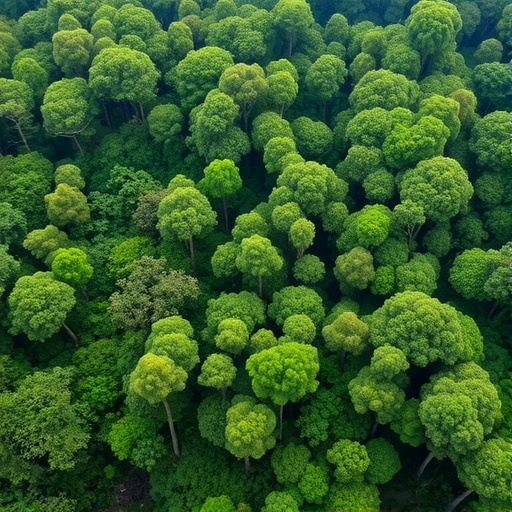The intricate relationships between carbon storage and biodiversity in forest ecosystems are gaining significant attention, especially within the expanse of the Amazon rainforest. Recent scientific investigations highlight critical aspects of this interaction, as studies uncover complex dynamics that influence both carbon sequestration and species diversity. This interplay is not merely an academic curiosity; it bears profound implications for climate change mitigation, conservation strategies, and the sustainable management of one of Earth’s most vital biomes.
As researchers delve deeper into the Amazon’s ecological framework, they reveal how various species contribute to carbon cycles. Trees, plants, and even microorganisms play essential roles in capturing atmospheric carbon dioxide through photosynthesis and facilitating its long-term storage in soil and biomass. However, the relationship between biodiversity and carbon storage is not straightforward. While richer diversity often promotes greater biomass and carbon storage, the mechanisms underlying this relationship remain an ongoing subject of exploration.
Moreover, recent systematic reviews, such as the one conducted by Mehta et al., provide crucial syntheses of existing knowledge on these interrelations. Their findings suggest that diverse forest ecosystems are superior in their capacity to sequester carbon compared to monoculture plantations. This insight underscores the critical importance of preserving biodiversity, as loss of species can significantly impair the ecosystem’s ability to function effectively and sequester carbon.
The research also touches upon the significance of local and regional environmental conditions in shaping these dynamics. Factors such as soil quality, precipitation patterns, and temperature can affect both the composition of plant communities and their carbon storage potential. By understanding these parameters, conservationists can better identify sanctuaries of biodiversity and potential hotspots for carbon sequestration that warrant protection from deforestation and degradation.
Additionally, the study reveals the impact of anthropogenic activities on forest ecosystems. Deforestation, land conversion for agriculture, and urban encroachment pose serious threats not just to biodiversity but also to the intricate carbon storage mechanisms of these systems. As the Amazon faces unprecedented pressures from human activities, the systematic review raises alarm bells about the potential for tipping points, where ecosystems could shift from being carbon sinks to additional sources of carbon emissions.
Field data from various sites in the Amazon demonstrate observable trends linking carbon storage and biodiversity. Areas rich in diverse species have shown higher rates of carbon uptake and storage, fostering resilience against climate variability. Therefore, preserving these biodiverse habitats is essential for bolstering ecosystem services, including climate regulation, water filtration, and habitat provision for countless species.
The authors also emphasize the role of indigenous knowledge in carbon management and biodiversity conservation. Indigenous practices have been honed over generations, providing insights into sustainable land management and stewardship. Recognizing and integrating this knowledge into broader conservation strategies could lead to more effective outcomes, as indigenous peoples often have a profound understanding of their local ecosystems and the intricate relationships that define them.
Another intriguing finding presented in the review involves the feedback loops between carbon cycling and biodiversity. For instance, increased carbon storage can enhance habitat quality, supporting greater biodiversity. Conversely, greater biodiversity can enhance ecosystem resilience and stability, allowing forests to withstand climatic perturbations and maintain their carbon storage functions.
As public awareness of climate change continues to grow, understanding the nexus between carbon and biodiversity becomes imperative. The implications of this research extend beyond academia, influencing policy-making, conservation efforts, and community engagement. It highlights the urgent need for comprehensive strategies that not only mitigate carbon emissions but also enhance biodiversity conservation as a dual approach to tackling climate change.
Moving forward, the study lays a foundation for future research. Empirical studies examining specific species interactions and their impacts on carbon sequestration are paramount. Understanding how particular species contribute to these processes at different ecological scales could inform more targeted conservation efforts and land management practices.
In conclusion, the systematic review sheds light on an intricate web of interactions that define ecological health and climate resilience in the Amazon. There is a pressing need to prioritize both carbon and biodiversity in forest ecosystems, as they are inherently linked in their contributions to global climate regulation. Failure to recognize and act upon these interdependencies could jeopardize not only the future of the Amazon but also the well-being of our planet.
The Amazon rainforest serves as a critical buffer against climate change, and the findings of this systematic review underscore the urgency of protecting its unparalleled biodiversity. Protecting and restoring these ecosystems is not merely an environmental imperative—it is vital for the sustainability of life on Earth as we navigate an era marked by rapid environmental changes and relentless human impact.
As these scientific insights proliferate in popular discourse, they carry the potential to galvanize public engagement in conservation initiatives, making the case for the Amazon as a global heritage. Recognizing the multifaceted benefits of preserving both carbon stocks and biodiversity could inspire actions that are not only environmentally sound but are socially and economically beneficial as well. The time to act is now, and robust, science-backed strategies can pave the way toward a more sustainable and resilient future.
Subject of Research: The interaction between carbon storage and biodiversity in forest ecosystems of the Amazon rainforest.
Article Title: Systematic review on carbon and biodiversity in forest ecosystems of Amazonia.
Article References: Mehta, D., Righi, C.A., Kumar, C. et al. Systematic review on carbon and biodiversity in forest ecosystems of Amazonia. Environ Monit Assess 197, 1307 (2025). https://doi.org/10.1007/s10661-025-14751-7
Image Credits: AI Generated
DOI: https://doi.org/10.1007/s10661-025-14751-7
Keywords: carbon, biodiversity, Amazon rainforest, carbon sequestration, ecosystem resilience, deforestation, conservation strategies.




